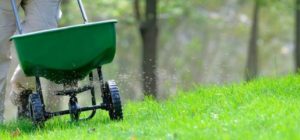
Control Broadleaf Perennial Weeds – The first job for homeowners on lawns in the fall is to make the lawn free of all broadleaf perennial weeds. No matter how thick the lawn is, weed seeds (dandelions, clover, plantain, etc.) have blown in over the spring and summer, and the immature weeds are growing in your lawns now. Ignore them this fall and you’ll surely have weeds next spring. Because we had regular rainfall over much of the summer when grass is under stress and not able to defend against weed encroachment, this is doubly true this fall. A full lawn application of liquid TRIMEC herbicide will easily solve this problem. Create a weed-free environment at the end of the weed growing season and you’ll have a lovely, weed-free lawn next April and May. Whenever applying TRIMEC, be sure that no rain is expected for at least 12 hours after application, withhold any seeding for two weeks, and do not mow for 24 hours before or after application.
Fertilizing in the Early Fall – Lawns are always in need of feeding at the end of a stressful summer growing season. This is doubly true at the end of a summer with lots of rain and when lawns continued growing in the hot weather. Lawn Depot slow-release, heavyweight turf food will help all lawns recover from summer stress, and green up and thicken up as we return to excellent turf growing conditions. This early fall feeding is the second most important feeding of the year (behind only the WINTERFEAST feeding in November-December), because the lawn is always exhausted at the end of summer. And with fall being the best season for cool weather grasses you’ll want to make established lawns greener and thicker, and newly seeded lawns will build a better root system after germination.
Seeding/Overseeding Lawns in September – In the fall, typically, the earth is warm which helps new seed germinate quickly, rainfall is usually more regular and morning dews are heavy, which also helps quick germination, and as the new seedlings establish after germination, the soil being warm (even as air temperatures cool significantly in October and beyond) helps the young plants develop denser and deeper root systems. Take advantage of Mother Nature and seed as early as you can after mid-August, water lightly and frequently to enhance early germination, fertilize to help both germinating seed and existing grass, and mow only DRY grass to avoid damaging newly germinating seed. The late fall WINTERFEAST fertilization will further build deeper denser root systems, you’ll love the way the lawn looks next spring; thick, dark green and weed-free.
Liming and/or Core Aerating Lawns in September – Both of these critical soil conditioning activities should be done every year to manage and improve growing conditions for turfgrass in our dense and acidic clay soils. Grass grows best in neutral loam. We have neither. Dense soils restrict root development, so it helps to open up the heavy soil with regular core aeration. Acidic soils restrict the nutritional value of turf fertilizers by bonding to the nitrogen and potassium in the turf food and rendering it unavailable for the turf. Neutralize acidic soils by regularly adding easy-to-apply pelletized lime. For faster-acting, high efficiency use TURF TURBO.
Checking for Grub Damage – Because of the recent dry spell and its browning-out effect on parts of many lawns, identification of lawn grub damage might be difficult to detect this fall. If you have had recent grub problems in sections of your lawn, or if you detected significant beetle activity in June and July, particularly if you neglected to apply a season-long grub control this past spring, you are advised to diligently scratch at areas of the lawn that green up more slowly than other areas after regular rainfall resumes. If the brown turf peels back easily to show populations of ½” long semi-circular whitish worms on the soil, immediately apply DYLOX grub killer by BioAdvanced and water in thoroughly. Then, when the grubs are controlled, scratch up dead turf and reseed the entire area. And we strongly urge all lawn owners to apply a grub preventer every spring.
